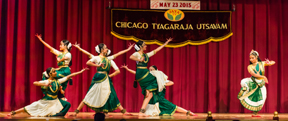
CHICAGO: Natya Dance Theatre (NDT) students enacted “Rama’s Childhood” (Baala-Kaandam) through Bharata Natyam set to pertinent songs of saintly musician-composer Thyagaraja at Hindu Temple of Greater Chicago on Thursday May 23.
NDT artistic director Hema Rajagopalan presented her choreography here at Hindu Temple of Greater Chicago as the packed culminating show of the first day of the Thyagaraja Festival. The young dancers maintained impeccable synchrony in their movements. Hema’s choreography had many brilliant and innovative touches that kept the narration moving along briskly. Costumes were simple yet elegant, in keeping with the whole production. She made creative use of several compositions (kritis), many in full, to develop the story line.
Thyagaraja’s operas such as “Prahlada Bhakthi Vijayam” and “Nauka Charithram” are eminently suitable for dance ballets. He composed many kritis in praise of Lord Rama but, unlike Arunachala Kavirayar with his Rama Natakam, none based on Ramayana itself. Harikatha (storytelling) exponent Balakrishna Sashtrigal and other scholars have woven some of Thyagaraja’s kritis into a narration of this epic.
The refrain “Vara Narada Narayana” (Vijayashri ragam-Adi talam) presented Lava and Kusa (Rama’s twin sons) as the narrators (sutra-dhara), who briefly introduced each scene. The English commentary on each scene was lucid. The performance proper opened with the auspicious “Sri Ganapathini”
(Sowrashtram-Adi) rendered as an energetic group dance. “Ramabhi Rama” (Darbar-Misra Chapu) depicted Kausalya’s maternal love (vaatsalyam) for Rama. The four young brothers-Rama, Lakshmana, Bharata and Shatrughna-learning Vedas and archery as apprentices under rishi Vasishta were presented next in pure dance.
The dialogue between Vishwamitra and Dasaratha had contrasting music to bring out the former’s stubbornness and the latter’s reluctance to part with Rama and Lakshmana. “Nannu Vidachi Kadalakura” (Reetigowla-Misra Chapu) conveyed the father’s anguish at this separation. In the forest, Vishwamitra ceremoniously wakes up the two sleeping princes with a brief “Kausalya Supraja Rama” followed by a doting “Meluko Dayanidhi” (Sowrashtram-Rupakam). The slaying of demoness Tataka featured a dramatic interplay of jatis (rhythmic syllables).
The rare kriti “Vachamagocharame” (Kaikavasi-Desadi) and “Gurulekha Etuvanti” (Gowrimanohari – Misra Chapu) depicted the guru-disciple relationship between Vishwamitra and Rama. Ahalya’s fleeting liaison with Indra was creatively choreographed to a dreamy Rasikapriya jatiswaram (dance movements alternating with swara patterns), a composition of the late violin maestro Lalgudi Jayaraman.
Spurned by her irate husband, the sage Gautama, the unwitting offender sings “Aparadhamulanorva” (Rasali-Adi). Turned into a stone, Ahalya is released by the magic touch of Rama’s foot, her gratitude beautifully captured by “Nannu Palimpa Nadachi Vachitivo” (Mohanam-Adi).
The grand swarajathi (jatiswaram with meaningful lyrics) “Tarijham ritajham” in Thodi was a novel way to portray Sita and friends playing ball in her terrace. A brisk jati “Tarittakka” heralded her entrance. Rama and Sita’s momentary encounter when “their eyes meet” inspires jubilant Sita to burst into “Kanukontini” (Bilahari-Adi).
Her marriage (svayamvaram) scene offered brilliant and comic performances by aspiring suitors, including Ravana. Their differing characteristics were illustrated by a medley of ragas, with Shivaranjani finally evoking king Janaka’s anxiety as to finding his daughter a suitable bridegroom.
After the breaking of the bow, a grand wedding scene unfolded with traditional songs like “Anandam anandam,” the swing (oonjal) song “Oyyalaloogavaiya” (Neelambari-Kanda Chapu) and a colorful dance with sticks (kummi) performed to the song “Nagumomu” (Madhyamavathi-Adi).
Kritis for this production, which premiered at CTU 1994 to live orchestra, were selected in consultation with Balakrishna Shastrigal. The now prerecorded music was the same and so was the choreography for the most part. “I was extremely pleased with the dancing and abhinaya (gestural representation),” said Rajagopalan, who is typically demanding of her students.
Shoba Natarajan






